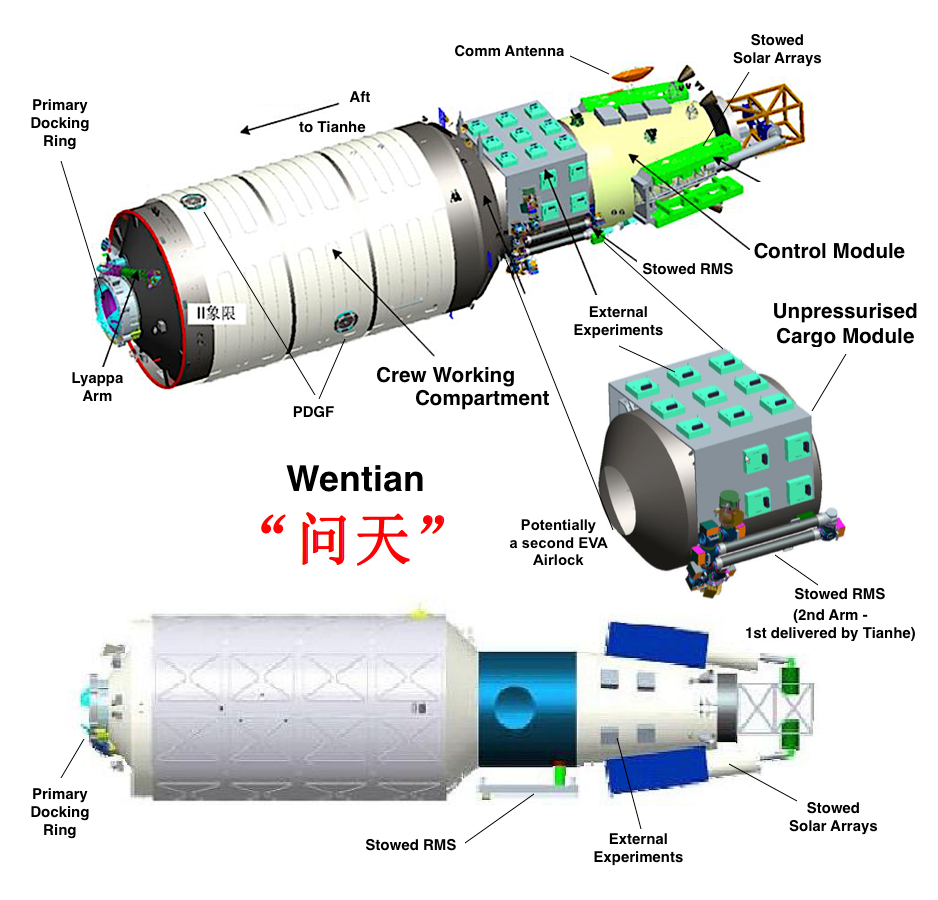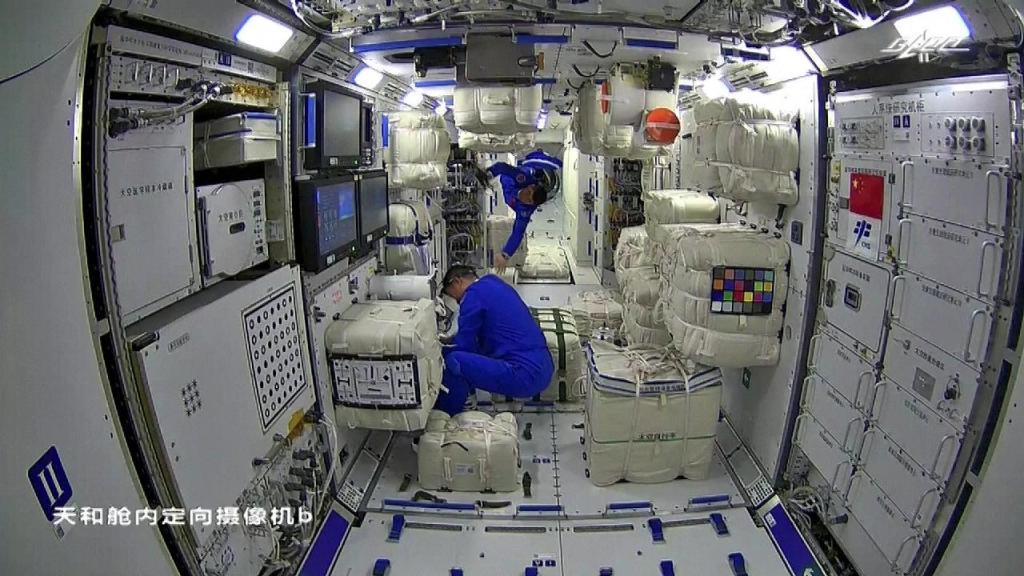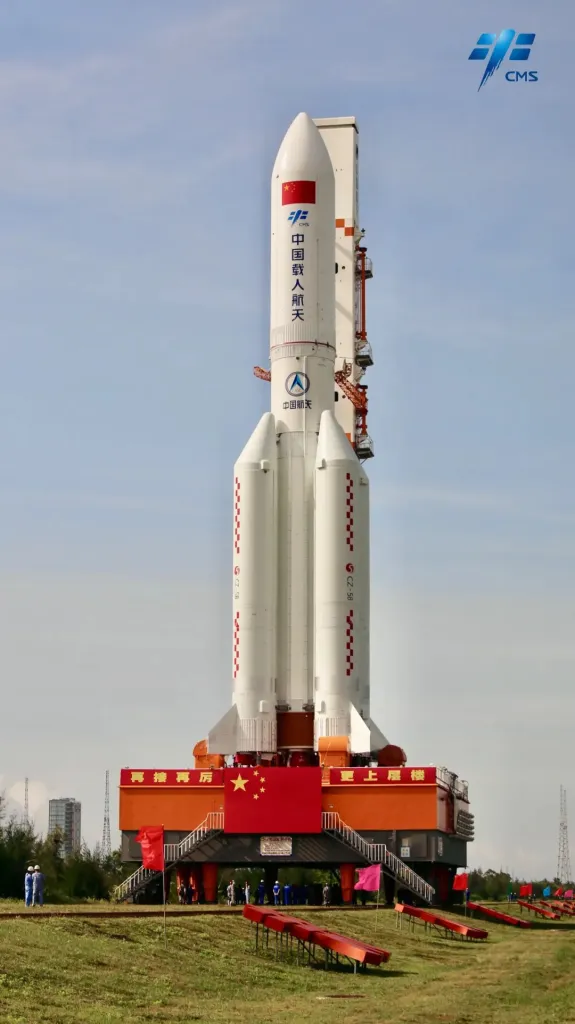Featured image: CMSA
Lift Off Time | July 24, 2022 – 06:22:32 UTC | 14:22:32 BJT |
|---|---|
Mission Name | Wentian, China’s modular space station’s laboratory module |
Launch Provider | China Aerospace Science and Technology Corporation (CASC) |
Customer | China Academy of Launch Vehicle Technology (CALT) |
Rocket | Long March 5B (CZ-5B) |
Launch Location | LC-1, Wenchang Space Launch Center, Hainan Island, China |
Payload mass | ~22,500 kg (49,600 lb) |
Where did the spacecraft go? | The Tianhe module of the Tiangong Space Station, low Earth orbit (LEO) – 370 km (230 mi), at a 41.0° inclination |
Did they attempt to recover the first stage? | No, this is not a capability of the Long March 5B |
Where did the first stage land? | TBD |
Did they attempt to recover the fairings? | No, this is not a capability of the Long March 5B |
Were these fairings new? | Yes |
This was the: | – 3rd launch of a Long March 5B variant – 2nd module launched to the Tiangong Space Station – 88th orbital launch attempt of 2022 (85th successful) |
Where to re-watch | If available, an official replay will be listed here |
How Did It Go?
China successfully launched the Wentian laboratory module, the second module of its space station Tiangong, to low Earth orbit. The module went into a circular orbit at 370 km altitude and a 41.0° inclination with respect to the equator. A Long March 5B rocket was used for this mission and lifted off from the Wenchang Space Launch Center in China, marking its third launch.

The Wentian Laboratory Module
Characteristics And Functions
The Wentian (“Quest for the heavens”) is the first laboratory module that extends the Tianhe core module launched on 29 April 2021 and provides a pressurized environment necessary for conducting science experiments in zero-gravity conditions. Moreover, this module is used as a backup for the Tianhe in terms of propulsion, orientation, and navigation functions.

The module has a length of 16.6 m (54 ft), a diameter of 4.2 m (14 ft), and a mass of ~22,500 kg (49,600 lb). The airlock in the Wentian lab module will serve as the main exit-entry point for extravehicular activities (EVAs) when the construction is completed. The node cabin in the Tianhe module will then serve as a backup. The power is provided by two 30-meter steerable solar panels that use photovoltaic cells and will significantly expand the power capabilities of the station.
After Docking
After launch, the Wentian took the place of the Tianzhou-3 cargo spacecraft recently separated from the station and docked at the forward port of the Tianhe module. The Wentian carries a robotic arm (Indexing robotic arm) that resembles the one used on the Mir space station and will take care of moving the module from the forward port to the planned radial port location.

Once docked, the module was entered by the Shenzhou-14 crew who activated the life-support systems and are now preparing the module for upcoming experiments. The experiment cabinets will be used to conduct research on space life sciences. Like the Tianhe, this laboratory module is equipped with living facilities for the taikonauts, including three sleeping areas, a toilet, and a kitchen. The station is now able to accommodate six people, meaning that crews will be able to change directly in orbit and the station will be continuously habitable.
The Tiangong Space Station
The Tiangong Space Station (meaning “heavenly palace”) is a space station currently under construction in LEO. When complete, the station will be roughly one-fifth the mass of the of the International Space Station. Construction began on April 29, 2021, when the core module, the Tianhe, which is able to accommodate three crew members with a built-in life support system, was launched on a Long March 5B rocket. The construction of the Tiangong is based on China’s two previous prototype space stations, the Tiangong-1 and the Tiangong-2.
China’s aim is to construct the three-module space station with 11 launches across 2021-2022, which will include 3 module launches, 4 cargo spacecraft, and 4 crewed missions. The station will be comprised of three modules, though it has the ability to expand to 6, and it is expected to be operational for at least 10 years.

At the moment, the space station accommodates the core module, Tianzhou-4 cargo vessel, and Shenzhou-14 crewed spaceship. The second lab module, Mengtian, is scheduled to arrive in October 2022 and will be located on the opposite radial port.
What Is The Long March 5B?
The Long March 5B has only flown twice before, in May 2020 and in April 2021. Those flights launched a prototype (un-crewed) spacecraft that China intends to use for deep space missions in the future and the Tianhe-1, China’s modular space station’s first module. Close attention was drawn to the re-entry of the massive first stage. Following its previous launch, it had entered and remained in orbit and made an uncontrolled re-entry.
The design of Long March 5B is to replace the usual upper stage with heavy modules such as those required to build out a modular space station.
Side Boosters
There are 4 side boosters attached to the core stage at lift-off. These are liquid-fueled boosters named CZ-5-300. Each side booster has two YF-100 engines.
At 27.6 m long, and 3.35 m diameter, these are substantial side boosters. Each one has a take-off mass of 156,600 kg (345,200 lb). Of this, 142,800 kg (314,800 lb) is propellant. The side boosters run on refined kerosene (RP-1) and liquid oxygen (LOx).
At sea level, each booster has a thrust of 2,400 kN (540,000 lbf). When in vacuum, this increases to 2,680 kN ( 600,000 lbf).
The combined thrust of the side boosters is 9,600 kN (2,200,000 lbf). They burn for a total time of 173 seconds before stage separation.

Core Stage
The core stage is named CZ-5-500 and has two YF-77 engines. The stage is 33.16 m (108.8 ft) tall and has a 5 m (16 ft) diameter. At lift-off, its total mass is 186,900 kg (412,000 lb).
The engines run on liquid hydrogen (LH2) and liquid oxygen (LOx). The stage has a thrust at sea level of 1,020 kN (230,000 lbf). When in vacuum, this increases to 1,400 kN (310,000 lbf).
The burn time of the core stage is 492 seconds, or 8 minutes 12 seconds.





